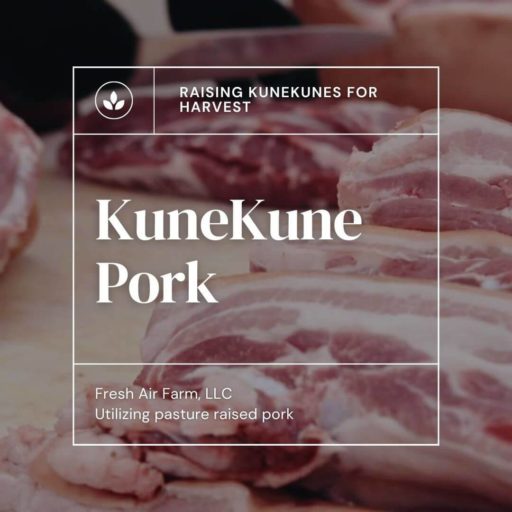
KuneKunes for Harvest
Raising KuneKunes for Harvest
by Fred & Donna German of Fresh Air Farm, LLC in Virginia
Enjoy this article about raising KuneKunes for Harvest which was shared with IKKPS member and KuneKune Breeder. Fresh Air Farm focuses on pasture raised pork production.
Visit their website at: Fresh Air Farm, LLC
The last few years have brought about a resurgence in homesteading and increased interest in KuneKune pigs among families wishing to raise their own food. This is due in part to the breed’s reputation for being an easily kept homestead pig as well as their succulent red meat. Learn more about KuneKunes for Pork.
KuneKunes are an excellent choice for homesteading.
Today, KuneKune pigs are recognized as a distinct breed by various agricultural organizations. The breed's placid temperament, along with its suitability for pasture-based farming, and rotational grazing practices have made it a popular choice for small-scale and sustainable food production. KuneKunes are a unique domestic pig that originated in New Zealand and were traditionally kept by the Māori people as a source of food. In the 1990s, KuneKune pigs were imported to the United States, where they quickly gained a following among small-scale farmers and homesteaders. If you’re looking for a smaller, well-tempered, easy to manage pig with quality meat, KuneKunes may be an excellent choice for your small farm or homestead.
About the KuneKune Pig.
Mature KuneKunes average 24-36 inches in height; have a short to medium neck and light to medium jowl. Their shoulders are level and in proportion with a moderately wide chest between the legs, and well-rounded hams. Adults weigh 200-400 pounds. When breeding KuneKunes with a specific focus on meat
production there are characteristics in addition to the conformation standards for consideration. Selecting the bloodlines of the breed that produces larger bodied, faster growing animals will be more desirable for this purpose.
KuneKune Pork
KuneKune pork has a variety of benefits that make it an attractive meat option. First, it is known for its rich and full flavor, with marbling that makes the meat tender and juicy. Additionally, KuneKune pigs that are raised on pasture and have access to natural forage, produce high-quality meat that is free from harmful additives. They are also a sustainable meat choice as they need less feed and produce less waste than other pig breeds. KuneKune pork is also a reliable source of protein, vitamins, and minerals, including heart- healthy omega-3 fatty acids.
Fundamentals you need for KuneKunes.
A rudimentary shelter and shade will keep KuneKunes out of the elements. And though they are cold tolerant, a barn will provide added warmth during the
winter months. A minimum of one quarter acre of pasture is needed for each adult KuneKune. Properly socialized KuneKunes are easy to manage and making them an excellent choice for rotational grazing agriculture which helps to minimize overgrazing and rooting.
Selecting Feed for your KuneKune.
When selecting feed for KuneKune meat pigs there are a few things to consider ensuring and healthy, well-nourished pig. A 12% protein feed is less expensive but
may extend time to market weight. Choosing a 16% protein feed may speed the growth of the animal but may also increase the ratio of fat to lean meat. Quantity of grain supplement will depend on time of year, and availability of quality pasture.
Pasture Management & Homesteading
Pasture management will depend on the region, climate, and species of forage available on any given farm or homestead. If reseeding pasture becomes necessary, deer plot blend, clover, or rye grass do well to satisfy the KuneKune palette.
Along with homesteading, holistic animal husbandry is gaining popularity. Herd management is key to this approach. Maintaining a closed herd is an effective way to limit the need for allopathic interventions. Herbal and non-chemical treatments for parasite control and illness can be used with vigilant management practices.
Though tractable, KuneKunes can become resistant during non-habitual routines. This is true especially during harvest time. Often, the simplest approach to handling hogs is the best approach. If the animal is accustomed to a holding area, this can serve as a dispatch point. When no holding area is available, field dispatching is an option.
Age of Harvest
The age and weight of market ready pigs are variable and depend on grazing conditions and feed supplementation. During the grazing season, KuneKunes put on 30-40 percent fat. Depending on the unique factors and the intended use by the consumer, these pigs can be grown out in 12-20 months and have an average hang weight of 60-100 pounds. Herniated boars make an excellent choice for small roasters.
The physiology of KuneKunes
The physiology of KuneKunes varies from traditional meat pigs producing an untraditional yield. They have a variety of common and unique meat cuts that make them a popular choice among small-scale producers and consumers. They share cuts such as the loin, shoulder, ham, and ribs with larger pigs that can be used in a variety of ways, including roasting, grilling, and smoking. The ‘high on the hog’ cuts such as tenderloins, chops, and ribs will be comparatively smaller in size much like lamb. More proper to the KuneKune pig are the ham, butts, jowls, and hocks.
The belly of the KuneKune pig is known for its rich and flavorful meat, which is often used to make bacon, pancetta, panhaus, headcheese, other cured pork products, and preservation processes such as charcuterie. The thick layer of fat on their back is used to make lard. This fat layer also produces a unique cut of meat called "pork coppa," which is like pork shoulder but has more marbling and a richer flavor.
The lard rendered from KuneKune pigs is known for its high quality and can be used in a variety of ways, such as frying and baking. Lardo, which is made from cured pork fat, is another unique product that is produced from KuneKune pigs. Lardo is a popular ingredient in Italian cuisine and is known for its delicate flavor and smooth texture. Overall, KuneKune pigs offer a range of meat and fat cuts that make them a versatile and popular choice among farmers, homesteaders, and chefs alike.
Harvesting at Home
Unlike USDA processing, at home hog harvesting is an opportunity for whole-animal utilization. A comprehensive list of basic skills and equipment is available on the South Dakota University Extension office website at: At-Home Hog Slaughter (sdstate.edu). Inexperienced home-butchers can gain these skills and practical knowledge by volunteering at a small farm, seeking a private mentor, or attending a workshop.
In Conclusion
With the rise in the cost of goods, consumers are becoming increasingly selective about how and where they spend their money. Whether you’re looking to produce your own food or retail a product, raising KuneKunes for harvest is a niche geared toward filling a gap in the marketplace. KuneKune pork offers a flavorful and sustainable meat option that comes with health benefits.
Registry Office
17500 Hamilton Arms Court Dewitt, VA 23840
